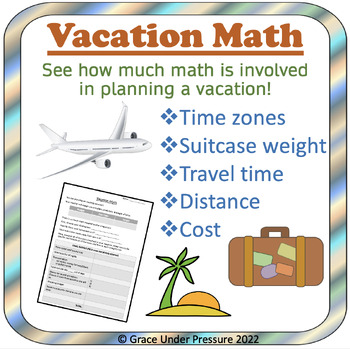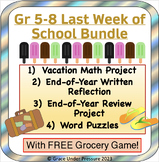Vacation Math: Middle School Budgeting Project with Problem Solving
Grace Under Pressure
327 Followers
Grade Levels
5th - 8th
Subjects
Resource Type
Standards
CCSS5.NBT.B.7
CCSS6.RP.A.3c
CCSS6.RP.A.3d
CCSSMP4
Formats Included
- PDF
- Easel Activity
Pages
6 pages
Grace Under Pressure
327 Followers
Easel Activity Included
This resource includes a ready-to-use interactive activity students can complete on any device. Easel by TPT is free to use! Learn more.
Also included in
- Do you need a few new activities for the last week of school in your intermediate or middle school class? I've got you covered with fun games, review activities, and worksheets that will keep your kids thinking and collaborating while having a blast! This ready-to-go bundle will keep your students iPrice $6.75Original Price $10.00Save $3.25
Description
This intermediate math project will get students excited about using math in everyday life!
They will plan a personal vacation including a flight, hotel, transportation, food, attractions, shopping and insurance.
You can assign students different budgets, start dates, and durations to differentiate, or give everyone the same constraints.
Students will have to practice making trade-offs to stick to their budget.
Six problem solving questions involving time zones, suitcase weight, taxes & fees, timeline, and travel speed are also included.
Total Pages
6 pages
Answer Key
N/A
Teaching Duration
3 hours
Report this resource to TPT
Reported resources will be reviewed by our team. Report this resource to let us know if this resource violates TPT’s content guidelines.
Standards
to see state-specific standards (only available in the US).
CCSS5.NBT.B.7
Add, subtract, multiply, and divide decimals to hundredths, using concrete models or drawings and strategies based on place value, properties of operations, and/or the relationship between addition and subtraction; relate the strategy to a written method and explain the reasoning used.
CCSS6.RP.A.3c
Find a percent of a quantity as a rate per 100 (e.g., 30% of a quantity means 30/100 times the quantity); solve problems involving finding the whole, given a part and the percent.
CCSS6.RP.A.3d
Use ratio reasoning to convert measurement units; manipulate and transform units appropriately when multiplying or dividing quantities.
CCSSMP4
Model with mathematics. Mathematically proficient students can apply the mathematics they know to solve problems arising in everyday life, society, and the workplace. In early grades, this might be as simple as writing an addition equation to describe a situation. In middle grades, a student might apply proportional reasoning to plan a school event or analyze a problem in the community. By high school, a student might use geometry to solve a design problem or use a function to describe how one quantity of interest depends on another. Mathematically proficient students who can apply what they know are comfortable making assumptions and approximations to simplify a complicated situation, realizing that these may need revision later. They are able to identify important quantities in a practical situation and map their relationships using such tools as diagrams, two-way tables, graphs, flowcharts and formulas. They can analyze those relationships mathematically to draw conclusions. They routinely interpret their mathematical results in the context of the situation and reflect on whether the results make sense, possibly improving the model if it has not served its purpose.







